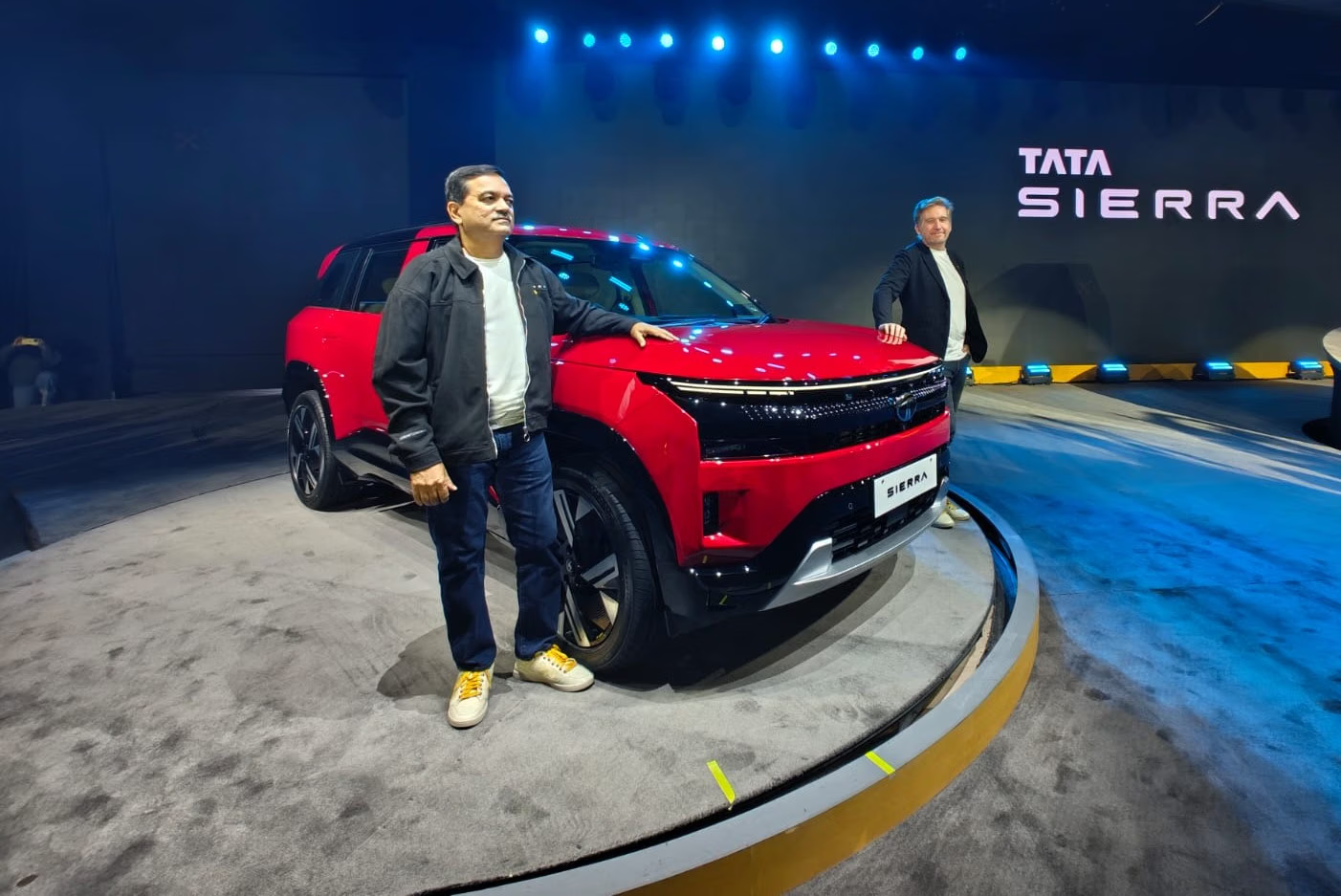Sierra Stakes its Claim for Top-Two in India’s Mid-Size SUV Market

As the Indian automotive industry heads into 2026, Tata Motors is preparing for what could be its most crucial SUV push so far. Having cemented leadership in the sub-compact segment with the Punch and in the compact SUV category with the Nexon, the company is now targeting the final and most contested frontier: the mid-size SUV space.
The all-new Sierra is at the centre of this strategy, positioned to take on the Hyundai Creta and Kia Seltos for a top two slot in the country’s most influential SUV category. As Shailesh Chandra, Managing Director and Chief Executive Officer of Tata Motors Passenger Vehicles Ltd, puts it, “We go with one simple philosophy that whatever cars we launch in whichever segment, it is in the top two.”
The mid-size SUV segment today accounts for roughly one-fifth to one-fourth of all SUV sales in India. With monthly volumes of 40,000 to 45,000 units, and with Creta contributing 12,000 to 14,000 units and the Seltos another 8,000 to 9,000, this remains the segment that shapes long-term market share for every serious OEM. The intensity is set to rise through 2026 with the arrival of the new Seltos, the next-generation Renault Duster and Mahindra’s first models based on the Victoris platform.
The Sierra enters this battleground as Tata Motors’ most carefully orchestrated challenge yet. Chandra believes “Not only can it take the current products very competitively in the mid-SUV but actually becomes even more compelling given that it stands out very differently in its segment.”
Completing Tata Motors’ SUV Pyramid
Tata Motors’ SUV strategy over the past five years has been deliberate. Punch and Nexon executed this mission to near perfection, giving the company a strong base of leadership at the sub-compact and compact ends.
The absence of a fully mainstream mid-size SUV, however, left a structural gap. The Sierra now fills that gap with a design-forward yet mass-market offering that pairs a mid-size-friendly footprint with interior space, material richness, and a distinctive silhouette. As Chandra describes it, “The extent of spaciousness, premiumness, tech stack, and the connection with an iconic brand all come together to make this a very compelling proposition.”
For the first time, Tata Motors will compete meaningfully across all three core SUV bands. Chandra adds, “With multi-powertrain options that we are giving, this should hopefully do well and help us plug the gap that we had in our portfolio.”
From 7,000 Units to 12,000 to 15,000 a Month: A Major Jump in Production Ambition
Tata Motors’ confidence in the Sierra rose sharply after its preview on 15 November, which drew a far stronger-than-expected response from customers, dealers, and social channels.
Initially, the company had advised its suppliers to prepare a production plan of around 7,000 units per month, typical for a new mid-size entrant.That guidance has now been revised. Vendors have been told to be ready for a production plan of 12,000 to 15,000 units per month beginning next year. This more than doubling of the initial outlook signals the company’s belief that the Sierra can scale quickly into the top tier of segment volumes. At the same time, executives acknowledge that the real test will lie in how sustained the demand remains once the initial novelty settles. As Chandra notes, “This kind of a compelling product will expand the segment.”
This scale-up also ensures Tata Motors avoids the supply bottlenecks that limited models like the Harrier and Safari in their early phases.
A Multi-Powertrain Playbook for a Fragmenting Market
The Sierra’s strategic strength lies in its breadth of propulsion choices. With buyers shifting between petrol, turbo-petrol, diesel and EVs, Tata Motors is offering one of the widest spreads in the category.
A new 1.5-litre naturally aspirated petrol engine anchors the entry point, and a 1.5-litre GDI turbo petrol targets performance-driven buyers. An upgraded diesel continues to cater to long-distance users, particularly in the North and South. The AWD-ready Argos architecture leaves room for future derivatives, while the pure-electric Sierra will ride a dedicated EV platform.
The Argos platform is a modular 4.3 to 4.6 metre architecture engineered for multiple propulsion systems, premium interiors, and future AWD iterations. It is one of Tata Motors’ highest-scale programmes, combining new hardware, a new software layer, and updated manufacturing systems.
Aiming for a Bigger Share of a Larger SUV Pie
Tata Motors currently holds about 16-17% of India’s SUV market. With Sierra entering the mid-size segment, the company believes it can lift that figure over time, with internal expectations suggesting a possible move toward the 20-25 percent range, depending on market behaviour. As Chandra says, “We are today 16 to 17 percent market share in SUVs. With Sierra, we feel confident that we will now be somewhere between 20 and 25 percent.” Senior executives also acknowledge that this is an aspiration, not a projection, given the competitive intensity expected in 2026.
A Complementary Role Beside the Harrier
While the Sierra and Harrier may fall in adjacent price clusters, their buyer profiles are expected to remain distinct. The Harrier appeals to customers seeking muscular proportions, diesel-powered performance, and a large-SUV persona.
The Sierra is expected to resonate with younger, more urban buyers who prioritise interior tech, design distinction, and everyday usability. As Chandra explains, “There is clear distinctness between who buys a Harrier versus who will buy a Sierra.”
This segmentation is expected to limit cannibalisation while broadening Tata Motors’ overall reach.
A Platform with Headroom
The modular Argos platform gives Sierra the option for future derivatives including the possibility of a seven-seat version or an AWD lifestyle variant if the market evolves in that direction. Tata Motors is handling these options cautiously and stresses that each derivative will have to stand on its own business case.
And in a segment crowded with similar silhouettes, Chandra underscores Sierra’s identity advantage: “If you keep ten mid-SUVs and Sierra, you will say this is different.”
A More Mature Tata Motors Enters 2026
The Sierra also reflects improvements in software integration, validation processes, and after-sales capability. Co-located supplier teams, synchronous software releases, modernised workshops, and AI-enabled diagnostics have all contributed to a more robust approach. The gains seen in Curvv and Harrier EV form the baseline for Sierra.
The Race for 2026 Begins
With multiple heavyweight launches scheduled, rising customer expectations, and a segment that accounts for nearly a quarter of India’s SUV demand, 2026 will be a decisive year for mid-size SUVs. The Sierra enters this space with a new platform, broad powertrain choices, stronger production planning, and a design-forward character that aims to give Tata Motors a shot at the competition.
At the same time, Tata Motors acknowledges that this segment is unforgiving, and the Sierra’s long-term performance will depend on sustained demand, reliability, and timely execution as rivals refresh their line-ups.
If the Sierra tracks the trajectory of the Punch and Nexon, Tata Motors could emerge as a leader or in the top two across all major SUV segments, though the path there is likely to be far more competitive than in earlier cycles.





